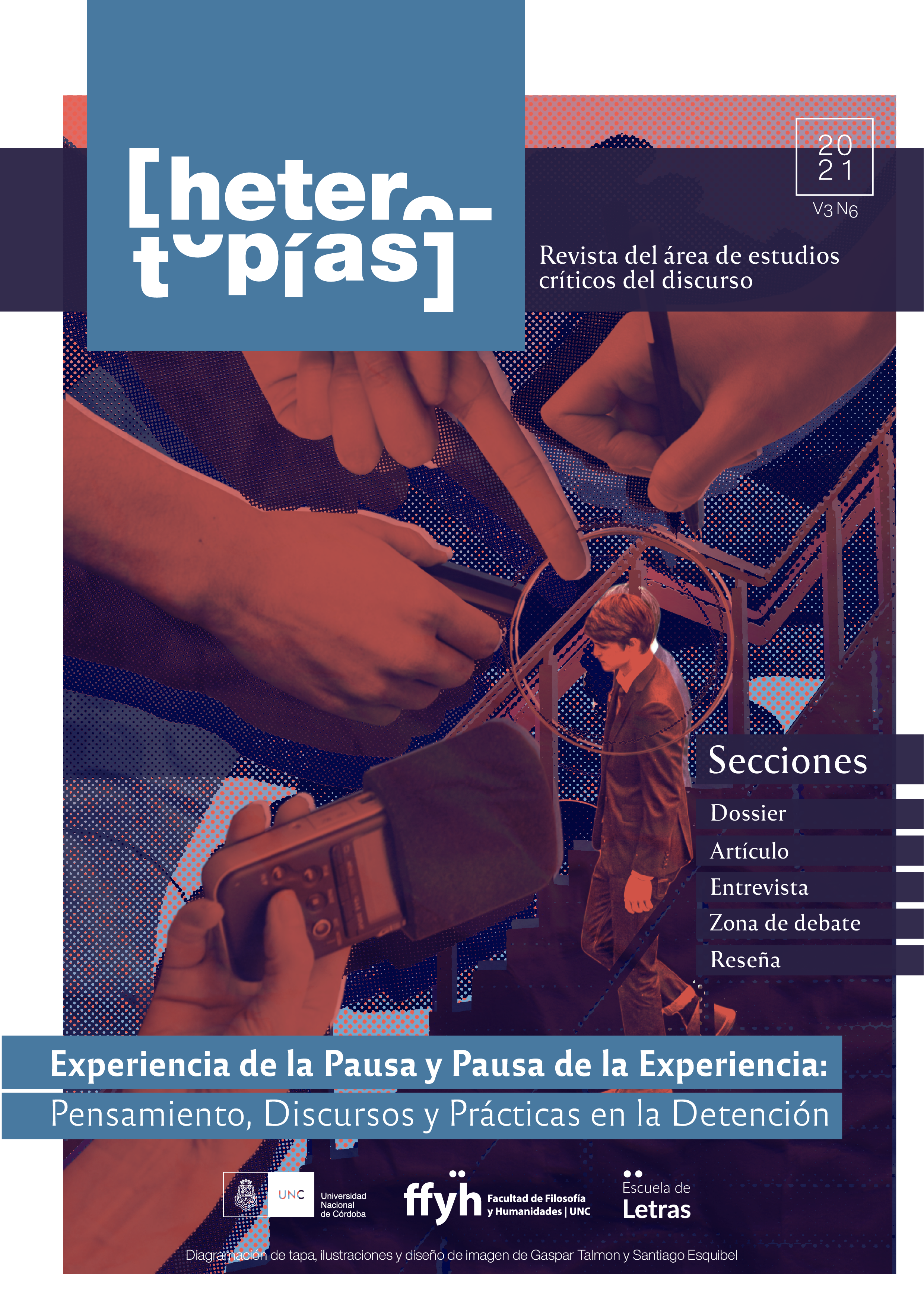The anthropogenic trauma Nightmares as theexperience of horror in a psycho-historicalperspective
Main Article Content
Abstract
According to Aby Warburg, the historical psyche, which is essentially schizofrenic in nature, originates from a primal phobos instilled by the Monstrum, that is, the Chaos or the non-human Outside. Based on Warburg's observation, I will demonstrate three theses: 1) the psychic cleavage Warburg suffere disrelated specifically to imagination; 2) to understand this psychic cleavage, two forms of imagination shoud be distinguished: a symbolic imagination, that join sorconnects two elements, and a diabolic imagination, that splits the elements and introduces a pause between them; and 3) the typical experience of schizofrenia that constitues Mnemosyne is the nightmare.
Downloads
Article Details

This work is licensed under a Creative Commons Attribution-NonCommercial-ShareAlike 4.0 International License.
Those authors who have publications with this journal, accept the following terms: Those authors who have publications with this journal, accept the following terms:
a. The authors will keep their copyright and guarantee to the journal the right of first publication of their work, which will be simultaneously subject to the Creative Commons Attribution - Non-Commercial - Share Alike (by-nc-sa) Attribution License; no commercial use of the original work or any derivative works is allowed, the distribution of which must be done with a license equal to the one that regulates the original work.
b. Authors may adopt other non-exclusive license agreements for the distribution of the published version of the work (e.g., deposit it in an institutional telematic archive or publish it in a monographic volume) provided that the initial publication in this journal is indicated.
c. Authors are allowed and recommended to disseminate their work through the Internet (e.g. in institutional telematic archives or on their website) before and during the submission process, which may lead to interesting exchanges and increase the number of citations of the published work. (See The effect of open access).
References
Agamben, G. (2005). Aby Warburg e la scienza senza nome. En La potenza del pensiero: saggi e conferenze (pp. 123-146). Vicenza: Neri Pozza.
Agamben, G. (1979). Stanze. La parola e il fantasma nella cultura occidentale. Torino: Einaudi.
Agamben, G. (2007). Ninfe. Torino: Bollati Boringhieri.
Baxter, A. (1737). An Inquiry into the Nature of the Human Soul, Vol. II. London: Printed for the Author.
Borges, J. L. (1975). La rosa profunda. Buenos Aires: Emecé.
Brisset, J.-P- (1913). Les origines humaines. Angers: Chez l’Auteur.
Bustriazo Ortiz, J. C. (2008). Herejía Bermeja. Buenos Aires: Ediciones En Danza.
Conrad, J. (1916). Heart of Darkness. New York: Doubleday, Page & Company.
Cragnolini, M. B. (1996). Nietzsche-Huidobro-Aschenbach: azores fulminados por la altura. Confines, 3, 185-198.
Deleuze, G. (1969). Logique du sens. Paris: Éditions de Minuit.
de Cirene, S. (2014). De insomniis. En D. A. Russell y H.-G- Nesselrath (eds.) On Prophecy, Dreams and Human Imagination: Synesius, De insommniis. (Edición crítica bilingüe con ensayos interpretativos). Tübingen: Mohr Siebeck.
de Daldis, A. (2012). Oneirokritika. En D. E. Harris-McCoy, Artemidorus' Oneirocritica: Text, Translation, and Commentary. Bilingual edition greek/english. Oxford: Oxford University Press.
Didi-Huberman, G. (2002). L’image survivant. Histoire de l'art et temps des fantômes selon Aby Warburg. Paris: Éditions de Minut.
Durand, G. (1964). L’Imagination symbolique. Paris: P.U.F.
Eliot, T. S. (1963). Collected Poems 1909-1962. New York: Harcourt,Brace&World, Inc.
Freud, S. (1922). Die Traumdeutung. Leipzig und Wien: Franz Deuticke.
Gombrich, E. H. (1948). Icones Symbolicae: The Visual Image in Neo-Platonic Thought. Journal of the Warburg and Courtauld Institutes, 11, 163-192.
Gombrich,E. H. (1970). Aby Warburg. An Intellectual Biography. London: The Warburg Institute.
Hillman, J. (1972). An Essayon Pan. New York: Spring Publications.
Johnson, C. D. (2012). Memory, Metaphor, and Aby Warburg’s Atlas of Images. New York: Cornell University Press.
Jones, E. (1931). Onthe Nightmare. London: The Hogarth Press.
Lacan, J. (1986). Séminaire VII. L'ethique de la psychanalyse, 1959-1960. Paris: Éditions du Seuil.
Laing, R. (1990). The Divided Self. An Existential Study in Sanity and Madness. London: PenguinBooks.
London, J. (1907). Before Adam. New York: TheMacMillan Company.
Macnish, R. (1834). The Philosophy of Sleep. New York: D. Appleton & Co.
Macrobio (2001). Commentaire au Songe de Scipion, 2 volumes. Édition bilingue latin/français. Introduction, traduction et notes de Mireille Armisen-Marchetti. Paris: Les Belles Lettres.
Michaud, P.-A. (2017). Aby Warburg y la imagen en movimiento. Buenos Aires: Libros UNA.
Nietzsche, F. (1988). Die Geburt der Tragödie. En Sämtliche Werke. Kritische Studienausgabe, ed. G. Colli y M.Montinari, Band I. Berlin – New York – München: W. de Gruytrer.
Papini, G. (1969). Il Diavolo. Appunti per una futura diabologia. Firenze: VallecchiEditore.
Pizarnik, A. (2002). Prosa completa. Barcelona: Editorial Lumen.
Prósperi, G. O. (2018). La respiración del Ser. Apnea y ensueño en la filosofía hegeliana. Buenos Aires: Miño y Dávila Editores.
Prósperi, G. O. (2019a). La máquina óptica. Antropología del fantasma y (extra)antropología de la imaginación. Buenos Aires: Miño y Dávila Editores.
Prósperi, G. O. (2019b). Del Monstruo a la Idea. Aby Warburg y la psico-arqueología del hombre. Cuadernos de Filosofía, 72, 37-51.Recuperado dehttp://revistascientificas.filo.uba.ar/index.php/CdF/article/view/7802/6874
Roscher, W. H. (1900). Ephialtes: Einepathologisch-mythologischeAbhandlungüber die AlptraumeundAlpdämonen des KlassischenAltertums. Leipzig: B. G. Teubner.
Saïd, S., (1987). Deuxnoms de l'image en grecancien: idole et icône. Comptes rendus des séances de l'Académie des Inscriptions et Belles-Lettres, 131-2, 309-330.
Saussure, F. de (1995). Cours de linguistique générale. Paris: Éditions Payot & Rivages.
Stanghellini, G. (2009). Embodiment and schizophrenia. World Psychiatry, 8:1, 56-59.
Vignoli, T. (1879). Mito e scienza: saggio. Milano: Fratelli Dumolard.
Warburg, A. (1932). Gesammelte Schriften, Band II. Die Erneuerung der heidnischen Antike, kulturwissenschaftliche Beiträgezur Geschichte der europäischen Renaissance. Leipzig – Berlin: B. G. Teubner.
Warburg, A. (2010). Atlas Mnemosyne. Madrid: Akal.
